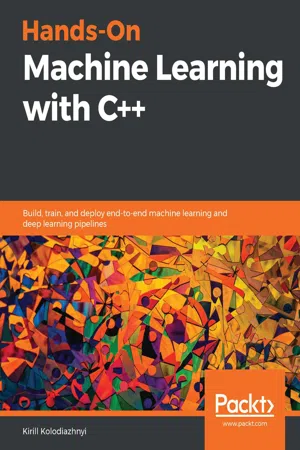
Hands-On Machine Learning with C++
Build, train, and deploy end-to-end machine learning and deep learning pipelines
- 530 pages
- English
- ePUB (mobile friendly)
- Available on iOS & Android
Hands-On Machine Learning with C++
Build, train, and deploy end-to-end machine learning and deep learning pipelines
About this book
Implement supervised and unsupervised machine learning algorithms using C++ libraries such as PyTorch C++ API, Caffe2, Shogun, Shark-ML, mlpack, and dlib with the help of real-world examples and datasets
Key Features
- Become familiar with data processing, performance measuring, and model selection using various C++ libraries
- Implement practical machine learning and deep learning techniques to build smart models
- Deploy machine learning models to work on mobile and embedded devices
Book Description
C++ can make your machine learning models run faster and more efficiently. This handy guide will help you learn the fundamentals of machine learning (ML), showing you how to use C++ libraries to get the most out of your data. This book makes machine learning with C++ for beginners easy with its example-based approach, demonstrating how to implement supervised and unsupervised ML algorithms through real-world examples.
This book will get you hands-on with tuning and optimizing a model for different use cases, assisting you with model selection and the measurement of performance. You'll cover techniques such as product recommendations, ensemble learning, and anomaly detection using modern C++ libraries such as PyTorch C++ API, Caffe2, Shogun, Shark-ML, mlpack, and dlib. Next, you'll explore neural networks and deep learning using examples such as image classification and sentiment analysis, which will help you solve various problems. Later, you'll learn how to handle production and deployment challenges on mobile and cloud platforms, before discovering how to export and import models using the ONNX format.
By the end of this C++ book, you will have real-world machine learning and C++ knowledge, as well as the skills to use C++ to build powerful ML systems.
What you will learn
- Explore how to load and preprocess various data types to suitable C++ data structures
- Employ key machine learning algorithms with various C++ libraries
- Understand the grid-search approach to find the best parameters for a machine learning model
- Implement an algorithm for filtering anomalies in user data using Gaussian distribution
- Improve collaborative filtering to deal with dynamic user preferences
- Use C++ libraries and APIs to manage model structures and parameters
- Implement a C++ program to solve image classification tasks with LeNet architecture
Who this book is for
You will find this C++ machine learning book useful if you want to get started with machine learning algorithms and techniques using the popular C++ language. As well as being a useful first course in machine learning with C++, this book will also appeal to data analysts, data scientists, and machine learning developers who are looking to implement different machine learning models in production using varied datasets and examples. Working knowledge of the C++ programming language is mandatory to get started with this book.
Frequently asked questions
- Essential is ideal for learners and professionals who enjoy exploring a wide range of subjects. Access the Essential Library with 800,000+ trusted titles and best-sellers across business, personal growth, and the humanities. Includes unlimited reading time and Standard Read Aloud voice.
- Complete: Perfect for advanced learners and researchers needing full, unrestricted access. Unlock 1.4M+ books across hundreds of subjects, including academic and specialized titles. The Complete Plan also includes advanced features like Premium Read Aloud and Research Assistant.
Please note we cannot support devices running on iOS 13 and Android 7 or earlier. Learn more about using the app.
Information
Section 1: Overview of Machine Learning
- Chapter 1, Introduction to Machine Learning with C++
- Chapter 2, Data Processing
- Chapter 3, Measuring Performance and Selecting Models
Introduction to Machine Learning with C++
- Understanding the fundamentals of ML
- An overview of linear algebra
- An overview of a linear regression example
Understanding the fundamentals of ML
Venturing into the techniques of ML
- Supervised learning is an approach based on the use of labeled data. Labeled data is a set of known data samples with corresponding known target outputs. Such a kind of data is used to build a model that can predict future outputs.
- Unsupervised learning is an approach that does not require labeled data and can search hidden patterns and structures in an arbitrary kind of data.
Supervised learning
- Classification models predict some finite and distinct types of categories—this could be a...
Table of contents
- Title Page
- Copyright and Credits
- About Packt
- Contributors
- Preface
- Section 1: Overview of Machine Learning
- Introduction to Machine Learning with C++
- Data Processing
- Measuring Performance and Selecting Models
- Section 2: Machine Learning Algorithms
- Clustering
- Anomaly Detection
- Dimensionality Reduction
- Classification
- Recommender Systems
- Ensemble Learning
- Section 3: Advanced Examples
- Neural Networks for Image Classification
- Sentiment Analysis with Recurrent Neural Networks
- Section 4: Production and Deployment Challenges
- Exporting and Importing Models
- Deploying Models on Mobile and Cloud Platforms
- Other Books You May Enjoy